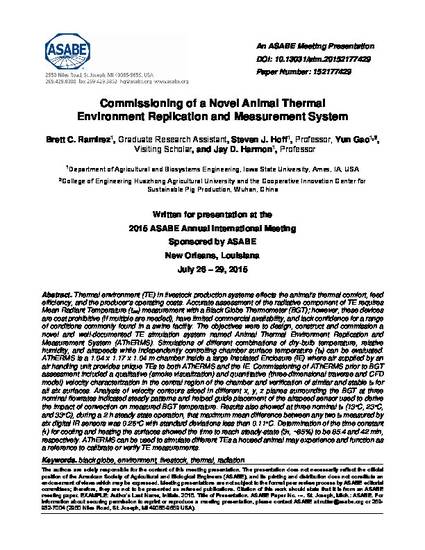
Thermal environment (TE) in livestock production systems effects the animal’s thermal comfort, feed efficiency, and the producer’s operating costs. Accurate assessment of the radiative component of TE requires Mean Radiant Temperature (tmr) measurement with a Black Globe Thermometer (BGT); however, these devices are cost prohibitive (if multiple are needed), have limited commercial availability, and lack confidence for a range of conditions commonly found in a swine facility. The objectives were to design, construct and commission a novel and well-documented TE simulation system named Animal Thermal Environment Replication and Measurement System (AThERMS). Simulations of different combinations of dry-bulb temperature, relative humidity, and airspeeds while independently controlling chamber surface temperature (ts) can be evaluated. AThERMS is a 1.04 x 1.17 x 1.04 m chamber inside a large Insulated Enclosure (IE) where air supplied by an air handling unit provides unique TEs to both AThERMS and the IE. Commissioning of AThERMS prior to BGT assessment included a qualitative (smoke visualization) and quantitative (three-dimensional traverse and CFD model) velocity characterization in the central region of the chamber and verification of similar and stable ts for all six surfaces. Analysis of velocity contours sliced in different x, y, z planes surrounding the BGT at three nominal flowrates indicated steady patterns and helped guide placement of the airspeed sensor used to derive the impact of convection on measured BGT temperature. Results also showed at three nominal ts (13°C, 23°C, and 33°C), during a 2 h steady state operation, that maximum mean difference between any two ts measured by six digital IR sensors was 0.26°C with standard deviations less than 0.11°C. Determination of the time constant (t) for cooling and heating the surfaces showed the time to reach steady-state (3t, ~95%) to be 85.4 and 42 min, respectively. AThERMS can be used to simulate different TEs a housed animal may experience and function as a reference to calibrate or verify TE measurements.
Available at: http://works.bepress.com/jay_harmon/129/

This proceeding is from 2015 ASABE Annual International Meeting, Paper No. 152177429, pages 1-13 (doi: 10.13031/aim.20152177429). St. Joseph, Mich.: ASABE.